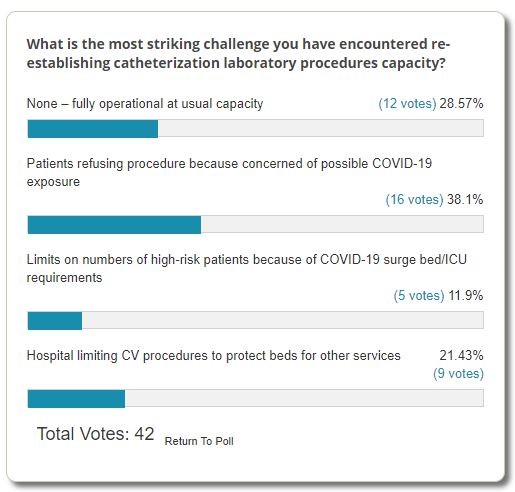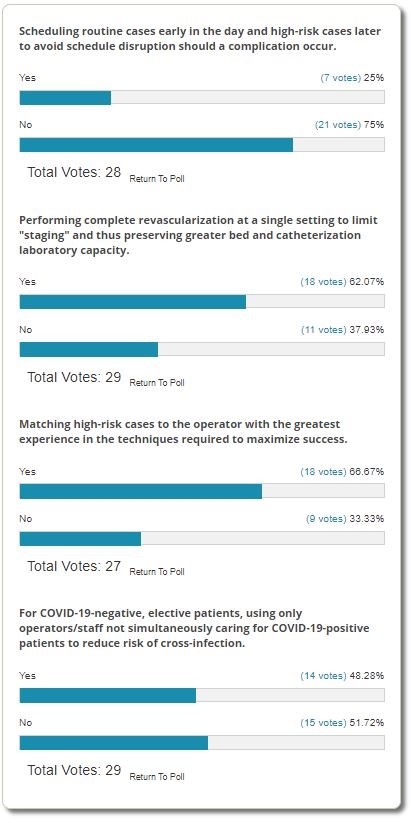Poll Results: Reimplementing CV Services
Quick Takes
- Nearly a third of catheterization laboratories have resumed normal reentry of cases.
- The greatest barrier to reentry is patients' concern about the risk of COVID-19 exposure.
- Operators tend to perform complete revascularization (avoiding staging) to minimize hospital days and admissions.
- Laboratories tend to match physician skills and experience to specific cases to optimize results and avoid complications.
This poll was aimed at addressing issues encountered and possible solutions for optimizing recovery of patients awaiting catheterization laboratory procedures. The responses are interesting.
In terms of barriers to treating patients, the most frequently selected (39%) was patients refusing the procedure because of concern about COVID-19 exposure. However, 29% of respondents reported no problems with accomplishing needed procedures, presumably resuming a relatively normal throughput. Also encouraging is the fact that a minority of respondents thought that hospital decisions or intensive care unit (ICU) bed issues were major barriers. Thus, many hospital settings are advancing to accommodate reentry of patients. Continued barriers are mostly related to patient concerns about infection risk. A number of opinion pieces, including a joint statement of the American College of Cardiology and Society for Cardiovascular Angiography and Interventions noting the safety of hospitals, has been published, and physicians have done some on their own. This remains a challenge for doctors, hospitals, and societies: to inform the public of the importance of needed health care during this crisis and the safety of hospitals when needed.
In terms of how patient management may have been adapted to the challenges of reentry, two responses were prominent: focus on complete revascularization and limit staging to maximize bed utilization. This is likely a recent and positive phenomenon in patient management, likely also supporting more complete revascularization. In addition, responses suggest hospital systems tended to support care by the appropriate physician for a case based on skills and/or experience for a particular procedure. Two other considerations were neutral or negative relating to scheduling sicker patients later in the day to avoid a laboratory shutdown due to issues of ICU bed capacity. This is likely not an issue because ICU bed capacity has never reached a critical level in most centers. Lastly, the avoidance of scheduling elective cases for doctors not taking care of COVID-19 patients was not needed or not feasible for smaller staff hospitals.
These are interesting results. As always, I thank the respondents and accept any comments.

Have you and/or your catheterization laboratory applied any of the following significant measures to optimize through-put and safety during the reimplementation of services?

Clinical Topics: COVID-19 Hub, Invasive Cardiovascular Angiography and Intervention, Noninvasive Imaging, Interventions and Imaging, Angiography, Nuclear Imaging
Keywords: COVID-19, severe acute respiratory syndrome coronavirus 2, Personnel, Hospital, Hospitals, Intensive Care Units, Delivery of Health Care, Catheterization, Coronary Angiography
< Back to Listings

